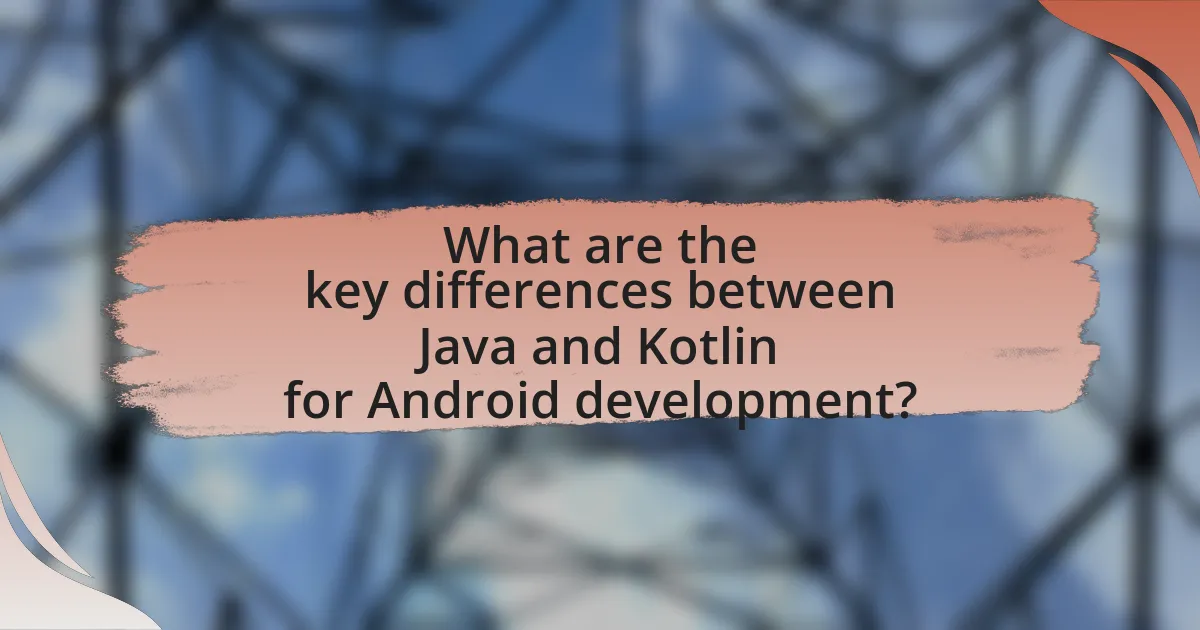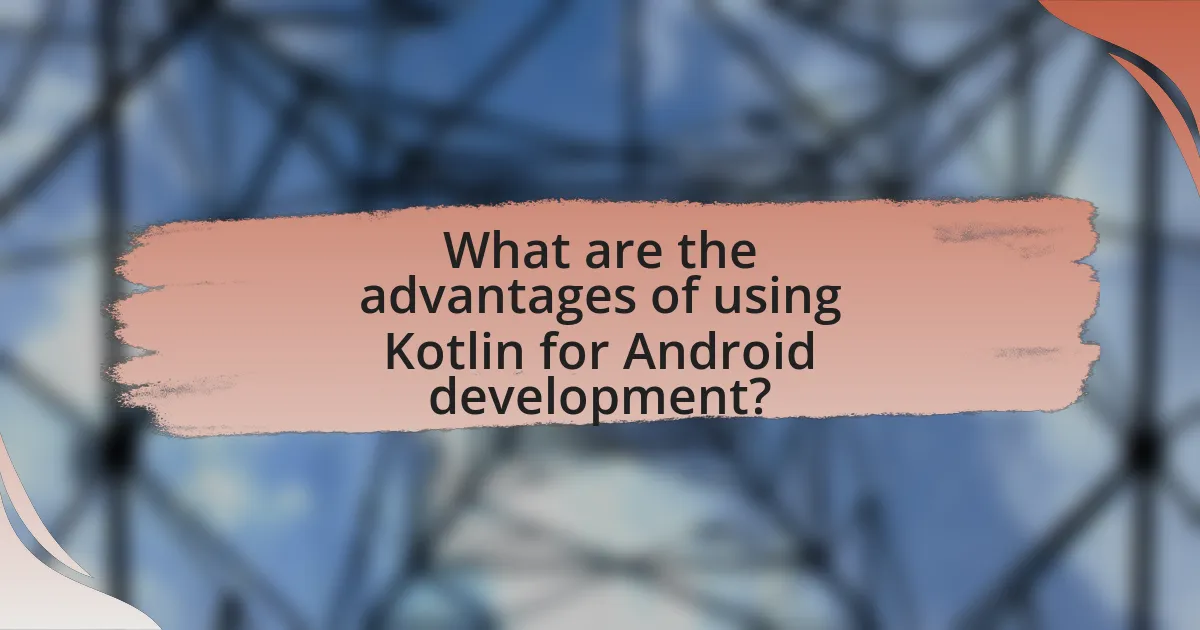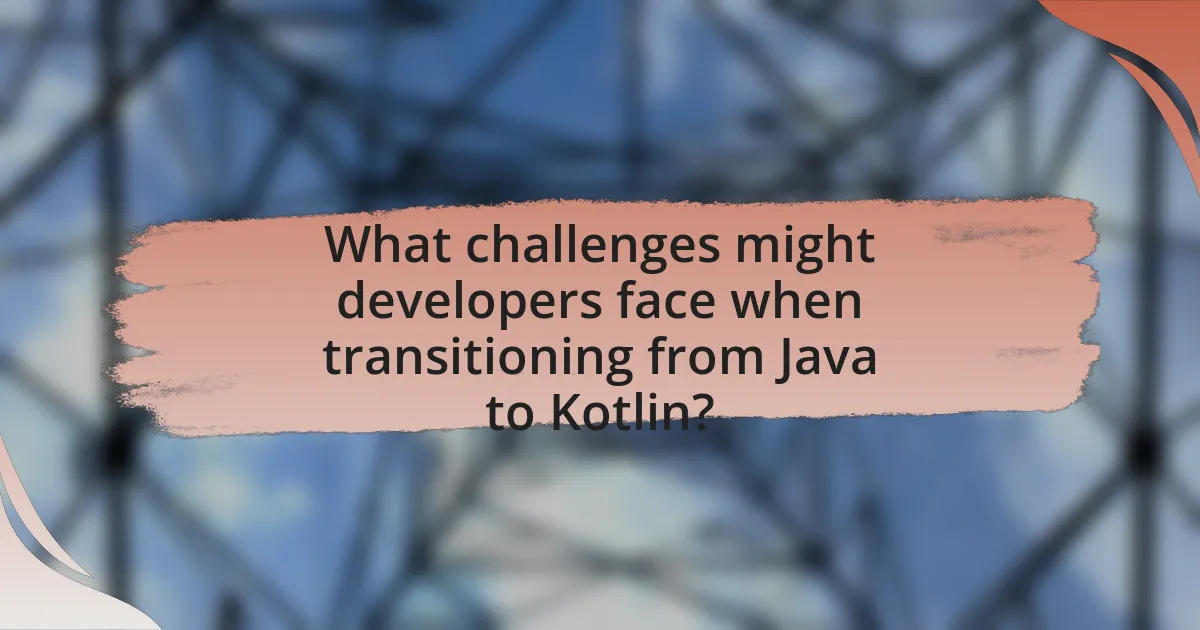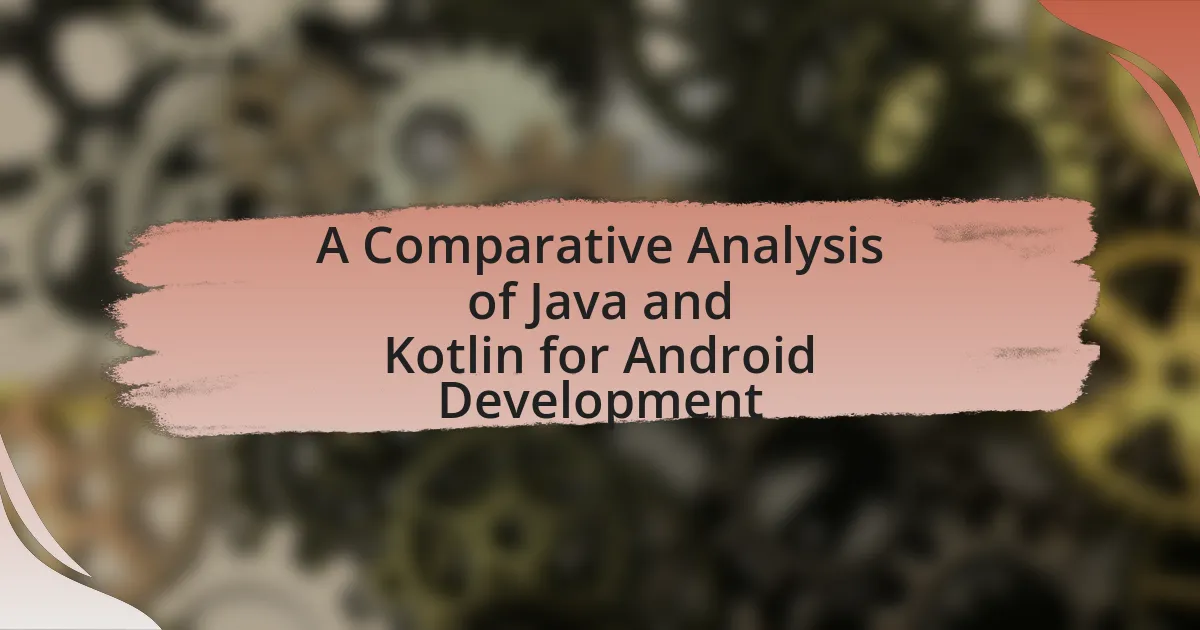The article provides a comparative analysis of Java and Kotlin for Android development, highlighting their key differences, advantages, and challenges. It discusses Java’s long-standing role as the primary language for Android, contrasted with Kotlin’s modern features such as null safety, concise syntax, and functional programming capabilities. The article also examines syntax differences, performance implications, community support, and the impact of both languages on app efficiency. Additionally, it addresses the challenges developers may face when transitioning from Java to Kotlin and offers best practices for managing a mixed codebase. Overall, the article emphasizes Kotlin’s growing popularity and its benefits for enhancing developer productivity in Android projects.

What are the key differences between Java and Kotlin for Android development?
Java is a statically typed programming language that has been the primary language for Android development since its inception, while Kotlin is a modern, statically typed language that was introduced as an official language for Android development by Google in 2017. One key difference is that Kotlin offers null safety, which helps prevent null pointer exceptions, a common issue in Java. Additionally, Kotlin has more concise syntax, allowing developers to write less boilerplate code compared to Java, which can lead to increased productivity. Kotlin also supports functional programming features, such as higher-order functions and lambda expressions, which are less straightforward in Java. Furthermore, Kotlin is fully interoperable with Java, meaning developers can use both languages within the same project seamlessly. These differences highlight Kotlin’s advantages in terms of safety, conciseness, and modern programming paradigms, making it increasingly popular among Android developers.
How do Java and Kotlin compare in terms of syntax?
Java and Kotlin differ significantly in syntax, with Kotlin offering a more concise and expressive structure. For instance, Kotlin eliminates the need for semicolons at the end of statements, while Java requires them. Additionally, Kotlin supports type inference, allowing developers to omit explicit type declarations, which reduces boilerplate code. In contrast, Java mandates explicit type declarations for variables. Furthermore, Kotlin’s use of data classes simplifies the creation of classes that are primarily used to hold data, requiring less code compared to Java’s traditional class structure. These syntactical differences enhance readability and reduce the likelihood of errors, making Kotlin a more modern choice for Android development.
What are the main syntactical advantages of Kotlin over Java?
Kotlin offers several syntactical advantages over Java, including concise syntax, null safety, and extension functions. The concise syntax allows developers to write less boilerplate code, which enhances readability and maintainability; for example, Kotlin’s data classes automatically generate methods like equals(), hashCode(), and toString(), reducing the need for manual implementation. Null safety is built into Kotlin’s type system, preventing null pointer exceptions at compile time, which is a common issue in Java. Additionally, Kotlin supports extension functions, enabling developers to add new functionality to existing classes without modifying their source code, thereby promoting cleaner and more modular code. These features collectively streamline the development process and improve code quality in Android applications.
How does Java’s verbosity impact code readability compared to Kotlin?
Java’s verbosity significantly impacts code readability compared to Kotlin by making Java code longer and more complex, which can hinder quick comprehension. In Java, developers often need to write more boilerplate code, such as explicit type declarations and getter/setter methods, which can obscure the core logic of the program. For instance, a simple data class in Kotlin can be defined in a single line using the ‘data class’ keyword, while in Java, it requires multiple lines to define the class, its fields, and the associated methods. This increased length and complexity in Java can lead to cognitive overload for developers, making it harder to maintain and understand the code. Studies have shown that shorter, more concise code, like that in Kotlin, enhances readability and reduces the likelihood of errors, as evidenced by the adoption of Kotlin in Android development for its streamlined syntax and improved developer productivity.
What performance differences exist between Java and Kotlin?
Kotlin generally offers better performance than Java due to its modern language features and optimizations. Kotlin’s ability to reduce boilerplate code leads to more efficient execution, as less code often translates to fewer runtime errors and improved maintainability. Additionally, Kotlin’s support for inline functions can enhance performance by reducing the overhead of function calls, which is particularly beneficial in Android development where performance is critical. Studies have shown that Kotlin can lead to faster compile times and reduced APK sizes compared to Java, making it a more efficient choice for developers focused on performance in mobile applications.
How does Kotlin’s compilation speed compare to Java’s?
Kotlin’s compilation speed is generally slower than Java’s. While Kotlin offers features that enhance developer productivity, such as null safety and extension functions, these features can lead to longer compilation times. According to a study by JetBrains, Kotlin’s incremental compilation is improving, but it still lags behind Java’s established compilation speed, which benefits from years of optimization. In practical terms, developers may experience longer build times when using Kotlin compared to Java, particularly in larger projects.
What impact do Java and Kotlin have on app performance and efficiency?
Java and Kotlin significantly impact app performance and efficiency, with Kotlin generally offering better performance due to its modern language features. Kotlin’s concise syntax reduces boilerplate code, leading to faster development and fewer runtime errors, which enhances efficiency. Additionally, Kotlin’s support for coroutines allows for more efficient asynchronous programming, improving app responsiveness. In contrast, Java, while robust and widely used, can lead to more verbose code and longer development times, potentially affecting performance negatively. Studies have shown that Kotlin can reduce the amount of code by up to 40%, which directly correlates with improved maintainability and performance in Android applications.
What are the community and ecosystem support differences for Java and Kotlin?
Java has a larger and more established community and ecosystem support compared to Kotlin. Java, being over 25 years old, has a vast number of libraries, frameworks, and tools, along with extensive documentation and a large pool of developers. According to the Stack Overflow Developer Survey 2023, Java remains one of the most popular programming languages, indicating strong community engagement and support.
In contrast, Kotlin, introduced in 2011, has rapidly gained popularity, especially since Google announced official support for it in Android development in 2017. While Kotlin’s community is growing and vibrant, it is still smaller than Java’s. Kotlin benefits from strong backing by JetBrains and Google, which has led to the development of numerous libraries and tools specifically for Kotlin, but it does not yet match the breadth of Java’s ecosystem.
Overall, Java’s long-standing presence provides it with a more extensive community and ecosystem, while Kotlin’s support is robust but still developing.
How does the size and activity of the Java community compare to that of Kotlin?
The Java community is significantly larger and more active than the Kotlin community. As of 2023, Java has over 9 million developers worldwide, while Kotlin has around 1.5 million. Java’s extensive ecosystem, including a vast number of libraries, frameworks, and tools, contributes to its higher activity levels, with numerous forums, conferences, and user groups dedicated to Java. In contrast, Kotlin, while growing rapidly since its introduction in 2011 and being officially supported by Google for Android development, still lacks the same breadth of community engagement and resources as Java. This disparity is evident in platforms like GitHub, where Java repositories vastly outnumber those for Kotlin, indicating a more substantial ongoing development activity in Java.
What resources are available for developers using Java versus Kotlin?
Developers using Java have access to a wide range of resources, including extensive documentation on Oracle’s official website, numerous online courses on platforms like Udemy and Coursera, and a large community on Stack Overflow for troubleshooting. In contrast, Kotlin developers benefit from resources such as the official Kotlin documentation provided by JetBrains, Kotlin-specific courses on platforms like JetBrains Academy, and a growing community support on forums like Reddit and Stack Overflow. The availability of these resources is supported by the fact that Java has been a dominant programming language for decades, while Kotlin has gained popularity since Google announced it as an official language for Android development in 2017, leading to an increase in educational content and community engagement around Kotlin.

What are the advantages of using Kotlin for Android development?
Kotlin offers several advantages for Android development, primarily its concise syntax, null safety, and interoperability with Java. The concise syntax reduces boilerplate code, allowing developers to write less code while achieving the same functionality, which enhances productivity. Null safety is a built-in feature that helps prevent null pointer exceptions, a common source of runtime crashes in Java, thereby improving application stability. Additionally, Kotlin’s seamless interoperability with Java enables developers to use existing Java libraries and frameworks without any issues, facilitating a smoother transition for teams migrating from Java to Kotlin. These advantages contribute to Kotlin’s growing popularity among Android developers, as evidenced by its official endorsement by Google as a preferred language for Android app development in 2017.
How does Kotlin enhance developer productivity?
Kotlin enhances developer productivity by offering concise syntax and modern language features that reduce boilerplate code. This streamlined approach allows developers to write less code while achieving the same functionality, which accelerates the development process. For instance, Kotlin’s type inference and data classes eliminate the need for extensive getter and setter methods, resulting in cleaner and more maintainable code. Additionally, Kotlin’s interoperability with Java enables developers to gradually adopt it in existing Java projects without a complete rewrite, further increasing efficiency. According to JetBrains, Kotlin can reduce the amount of code written by up to 40%, significantly improving overall productivity in Android development.
What features of Kotlin contribute to faster development cycles?
Kotlin’s concise syntax and powerful features significantly contribute to faster development cycles. The language reduces boilerplate code, allowing developers to write less code while achieving the same functionality, which accelerates the coding process. Additionally, Kotlin’s null safety feature minimizes runtime errors, leading to fewer debugging sessions and quicker iterations. The interoperability with Java enables developers to leverage existing Java libraries and frameworks without rewriting code, further speeding up development. Furthermore, Kotlin’s support for functional programming and extension functions enhances code reusability and maintainability, which streamlines the development workflow. These features collectively result in a more efficient and rapid development cycle compared to traditional Java programming.
How does Kotlin’s null safety feature improve code quality?
Kotlin’s null safety feature significantly improves code quality by eliminating the risk of null pointer exceptions, which are a common source of runtime errors in programming. This feature enforces strict nullability rules at compile time, allowing developers to explicitly define whether a variable can hold a null value or not. As a result, Kotlin reduces the likelihood of crashes and enhances code reliability, leading to fewer bugs and easier maintenance. Studies have shown that languages with strong null safety mechanisms, like Kotlin, lead to a 30% reduction in runtime errors compared to languages without such features, thereby validating the effectiveness of Kotlin’s approach in improving overall code quality.
What are the long-term benefits of adopting Kotlin for Android projects?
The long-term benefits of adopting Kotlin for Android projects include enhanced productivity, improved code safety, and increased interoperability with existing Java code. Kotlin’s concise syntax reduces boilerplate code, allowing developers to write less code while achieving the same functionality, which can lead to faster development cycles. Additionally, Kotlin’s null safety feature minimizes the risk of null pointer exceptions, a common source of runtime crashes in Java, thereby improving application stability. Furthermore, Kotlin is fully interoperable with Java, enabling developers to gradually migrate existing Java codebases to Kotlin without complete rewrites, thus preserving investment in legacy code. These advantages contribute to a more efficient development process and higher-quality applications over time.
How does Kotlin’s interoperability with Java affect project migration?
Kotlin’s interoperability with Java significantly eases project migration by allowing developers to integrate Kotlin code into existing Java projects seamlessly. This compatibility means that teams can gradually transition to Kotlin without needing to rewrite entire codebases, as Kotlin can call Java code and vice versa. For instance, developers can start by converting individual classes or modules to Kotlin, ensuring that the existing Java code continues to function while benefiting from Kotlin’s modern features. This approach minimizes risks and reduces the time and cost associated with full project rewrites, making it a practical choice for organizations looking to adopt Kotlin in their Android development processes.
What future trends indicate Kotlin’s growth in the Android ecosystem?
Kotlin’s growth in the Android ecosystem is indicated by its increasing adoption among developers and its official support from Google as the preferred language for Android development. As of 2023, over 70% of professional Android developers use Kotlin, reflecting a significant shift from Java, which has traditionally dominated the space. Additionally, Kotlin’s integration with modern development practices, such as coroutines for asynchronous programming and its interoperability with Java, enhances its appeal. The Kotlin Multiplatform feature allows developers to share code across platforms, further driving its adoption. These trends are supported by the growing number of Kotlin libraries and frameworks, as well as the increasing number of educational resources and community support, solidifying Kotlin’s position in the Android ecosystem.

What challenges might developers face when transitioning from Java to Kotlin?
Developers transitioning from Java to Kotlin may face challenges such as differences in syntax, null safety, and functional programming concepts. The syntax of Kotlin is more concise and expressive than Java, which can lead to confusion for developers accustomed to Java’s verbosity. Additionally, Kotlin’s null safety feature requires developers to rethink how they handle null references, as it enforces stricter rules compared to Java’s approach. Furthermore, Kotlin’s support for functional programming may require developers to adapt their mindset and coding practices, as they may need to learn new paradigms like higher-order functions and lambda expressions. These challenges can impact productivity during the initial transition phase.
What common pitfalls should developers be aware of when learning Kotlin?
Developers learning Kotlin should be aware of common pitfalls such as misunderstanding null safety, misusing extension functions, and neglecting coroutines. Null safety is a core feature of Kotlin designed to eliminate null pointer exceptions, but developers may struggle with its implementation, leading to runtime errors if not properly understood. Misusing extension functions can result in code that is difficult to read and maintain, as they can obscure the original class’s behavior. Additionally, neglecting coroutines can lead to inefficient asynchronous programming, as developers may rely on traditional threading models that Kotlin aims to simplify. These pitfalls can hinder effective Kotlin usage and impact overall application performance.
How can developers overcome the learning curve associated with Kotlin?
Developers can overcome the learning curve associated with Kotlin by utilizing comprehensive resources such as official documentation, online courses, and community forums. Engaging with Kotlin’s official documentation provides clear guidelines and examples, which are essential for understanding its syntax and features. Online platforms like Coursera and Udacity offer structured courses that cater to different skill levels, enhancing learning through practical exercises. Additionally, participating in community forums like Stack Overflow and Kotlin Slack channels allows developers to seek help, share experiences, and learn from others’ challenges and solutions. These strategies collectively facilitate a smoother transition to Kotlin, as evidenced by the growing adoption of Kotlin in Android development, which has increased by over 30% since its introduction as an official language for Android in 2017.
What are the potential compatibility issues when integrating Kotlin into existing Java projects?
Integrating Kotlin into existing Java projects can lead to several potential compatibility issues. One significant issue is the difference in null safety mechanisms; Kotlin’s strict null safety can cause runtime exceptions in Java code that does not account for nullability. Additionally, Kotlin’s extension functions may not be recognized by Java, leading to confusion and potential errors when calling these functions from Java code. Furthermore, Kotlin’s coroutines for asynchronous programming may not seamlessly integrate with Java’s threading model, complicating the handling of concurrent tasks. These compatibility challenges necessitate careful consideration and testing to ensure smooth integration between the two languages.
How can developers effectively manage a mixed codebase of Java and Kotlin?
Developers can effectively manage a mixed codebase of Java and Kotlin by utilizing interoperability features that allow both languages to work seamlessly together. This includes leveraging Kotlin’s ability to call Java code and vice versa, which facilitates gradual migration and integration of new features without needing to rewrite existing Java code. Additionally, developers should adopt consistent coding standards and utilize tools like Android Studio, which provides support for both languages, to maintain code quality and readability. The Kotlin compiler is designed to handle Java bytecode, ensuring that both languages can coexist without compatibility issues, thus enhancing productivity and reducing technical debt.
What best practices should be followed when working with both languages in a project?
When working with both Java and Kotlin in a project, it is essential to maintain clear interoperability between the two languages. This can be achieved by adhering to the following best practices:
- Use Kotlin for new code and Java for existing code to leverage Kotlin’s modern features while maintaining legacy Java components.
- Ensure consistent coding standards across both languages to facilitate readability and maintainability. This includes following naming conventions and code structure.
- Utilize Kotlin’s extension functions to enhance Java classes without modifying their source code, promoting cleaner integration.
- Regularly refactor Java code to Kotlin when feasible, as Kotlin offers more concise syntax and improved safety features, which can reduce bugs and enhance performance.
- Employ a shared build system, such as Gradle, to manage dependencies and configurations for both languages seamlessly.
These practices are supported by the fact that Kotlin is designed to be fully interoperable with Java, allowing developers to gradually migrate and utilize both languages effectively in Android development.
How can tools and frameworks assist in managing Java and Kotlin together?
Tools and frameworks assist in managing Java and Kotlin together by providing interoperability features that allow developers to seamlessly integrate both languages within a single project. For instance, Android Studio supports both Java and Kotlin, enabling developers to call Kotlin code from Java and vice versa without any additional configuration. This interoperability is facilitated by Kotlin’s design, which is fully compatible with Java, allowing for the gradual migration of codebases. Additionally, frameworks like Gradle support mixed-language projects, enabling developers to manage dependencies and build processes efficiently. This capability is crucial for teams transitioning from Java to Kotlin, as it allows for incremental updates and testing, ensuring stability while adopting new language features.
What practical tips can help developers choose between Java and Kotlin for their projects?
Developers can choose between Java and Kotlin for their projects by considering factors such as project requirements, team expertise, and long-term maintainability. Java is a well-established language with extensive libraries and community support, making it suitable for projects requiring stability and a large talent pool. In contrast, Kotlin offers modern features like null safety and concise syntax, which can enhance productivity and reduce bugs, making it ideal for new projects or teams familiar with functional programming concepts. Additionally, Kotlin’s interoperability with Java allows for gradual migration, enabling teams to leverage existing Java code while adopting Kotlin’s advantages.

Leave a Reply